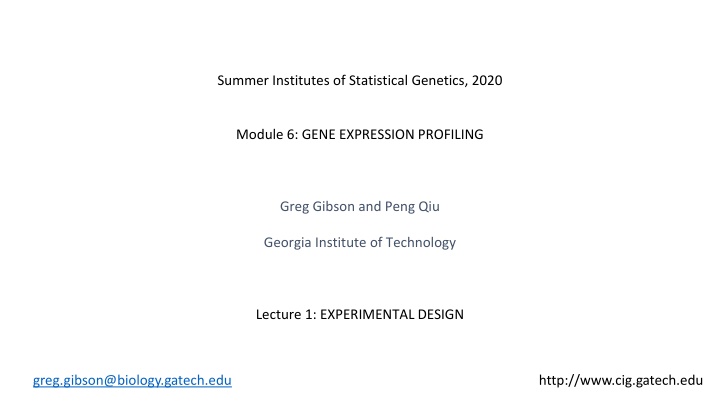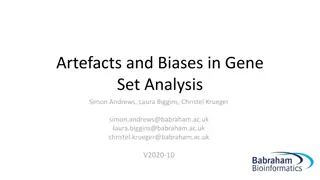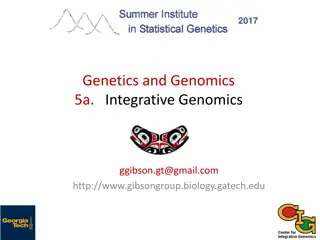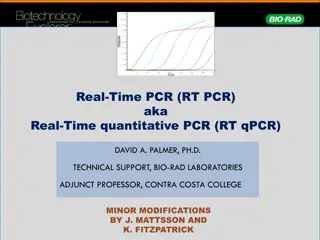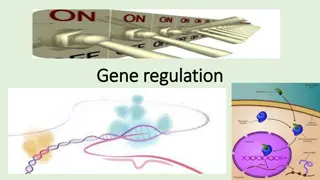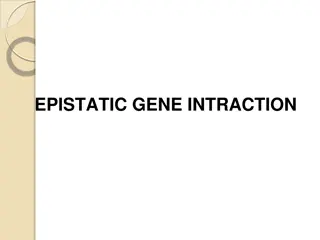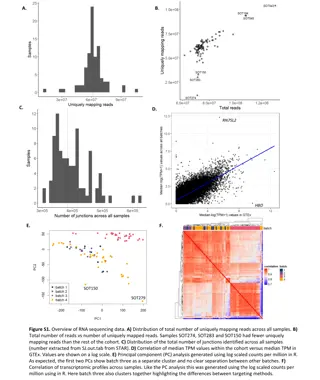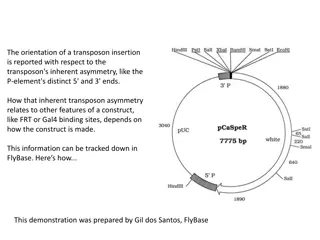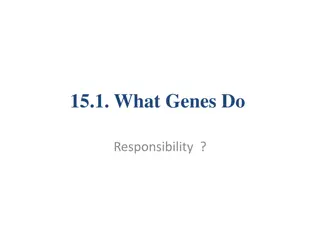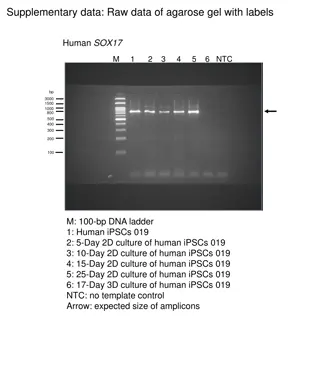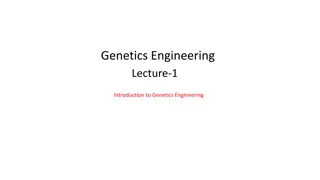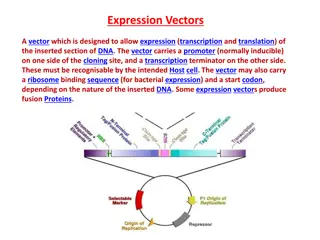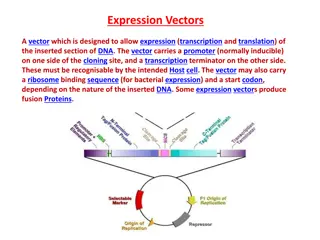Gene Expression Profiling in Statistical Genetics Summer Institute 2020
This content provides information on the Summer Institutes of Statistical Genetics module, focusing on gene expression profiling. It includes details on the schedule, experimental design, RNA sequencing workflow, modes of bulk RNA sequencing, and RNASeq software. The content discusses crucial steps in a gene expression profiling study, such as experimental design, RNA sequencing, short read alignment, and normalization. Additionally, it covers topics like hypothesis testing, genetic analysis, and downstream analyses in gene expression studies.
Download Presentation

Please find below an Image/Link to download the presentation.
The content on the website is provided AS IS for your information and personal use only. It may not be sold, licensed, or shared on other websites without obtaining consent from the author.If you encounter any issues during the download, it is possible that the publisher has removed the file from their server.
You are allowed to download the files provided on this website for personal or commercial use, subject to the condition that they are used lawfully. All files are the property of their respective owners.
The content on the website is provided AS IS for your information and personal use only. It may not be sold, licensed, or shared on other websites without obtaining consent from the author.
E N D
Presentation Transcript
Summer Institutes of Statistical Genetics, 2020 Module 6: GENE EXPRESSION PROFILING Greg Gibson and Peng Qiu Georgia Institute of Technology Lecture 1: EXPERIMENTAL DESIGN greg.gibson@biology.gatech.edu http://www.cig.gatech.edu
SISG Module 6 Schedule Date Time (PST) Time (EST) Topic Instructor Wednesday, July 15 11:30 12:00 2:30 3:00 Introductions 12:00 1:00 3:00 4:00 Experimental Design for Gene Expression Profiling GG 1:00 1:20 4:00 4:20 Break 1:20 2:20 4:20 5:20 Hypothesis Testing, Significance and Power GG Thursday, July 16 8:00 9:00 11:00 12:00 Foundations of Clustering PQ 9:00 9:20 12:00 12:20 Break 9:20 10:20 12:20 1:20 Normalization of Transcriptome Datasets GG Thursday, July 16 12:00 1:00 3:00 4:00 ATACseq, Methylation, and Intro to scRNAseq GG 1:00 1:20 4:00 4:20 Break 1:20 2:20 4:20 5:20 Dimension Reduction Approaches PQ Friday, July 17 8:00 9:00 11:00 12:00 Clustering for scRNAseq Analysis PQ 9:00 9:20 12:00 12:20 Break 9:20 10:20 12:20 1:20 Trajectory Finding for scRNAseq Analysis PQ Friday, July 17 12:00 1:00 3:00 4:00 eQTL and Genetics of Gene Expression GG 1:00 1:20 4:00 4:20 Break 1:20 2:20 4:20 5:20 Co-occurrence Clustering for scRNAseq Analysis PQ
Steps in a Gene Expression Profiling Study 1. Experimental Design (this afternoon) 2. RNA Sequencing (next) 3. Short read alignment (this afternoon) 4. Normalization (tomorrow morning) 5. Hypothesis testing (after the break today) 6. Downstream analyses (Module 10) 7. Genetic analysis (Friday afternoon)
Modes of Bulk RNA sequencing RNA is prepared, mRNA is captured on polyT beads, fragmented, and converted to cDNA using either a stranded or unstranded protocol, usually with 12-24X multiplexing 1. Single-end reads Maximizes the total number of independent reads (50M optimal) When RNA is degraded, eg FFPE specimens 2. Paired-end reads Slightly more accurate alignment But typically lower coverage (25M reads) Better for estimation of alternate splicing and ASE 3. 3 targeted Lexogen protocol is one fifth the cost ($70 vs $350 per sample) Ideal for large sample studies when funds are a concern Single Cell drop digital dd-scRNASeq is also 3 targeted
RNAseq Software 1. Short Read Alignment STAR HISAT2 https://github.com/alexdobin/STAR/releases https://ccb.jhu.edu/software/hisat2/index.shtml 2. Read counting HTseq SAMtools http://www-huber.embl.de/HTSeq/doc/overview.html http://www.htslib.org/ 3. Differential Expression DESeq DExSeq edgeR Voom http://web.mit.edu/~r/current/arch/i386_linux26/lib/R/library/limma/html/voom.html https://bioconductor.org/packages/release/bioc/html/DESeq2.html https://www.bioconductor.org/packages/release/bioc/html/DEXSeq.html https://bioconductor.org/packages/release/bioc/html/edgeR.html 4. Data Normalization SVASeq Combat PEER SNM https://www.bioconductor.org/packages/release/bioc/html/sva.html https://www.rdocumentation.org/packages/sva/versions/3.20.0/topics/ComBat http://www.sanger.ac.uk/science/tools/peer https://www.bioconductor.org/packages/release/bioc/html/snm.html Another option is the Tuxedo protocol (Bowtie, Tophat, Cufflinks, Cuffdiff, https://ugene.net/wiki/display/WDD31/RNA-seq+Analysis+with+Tuxedo+Tools
Basics of Experimental Design: Levels of Replication Often you will have a fixed budget that constrains how many arrays can be processed. So your first task is to determine what levels of replication you can afford, and how they will impact statistical power. Technical Replication: - RNA preparation (eg. from adjacent biopsies) - cDNA synthesis (pooling minimizes outlier effects) - library preparation - sequencing lane or array hybridization (usually a minimal effect) Biological Replication: Fixed effects: - sex - treatment (drug, growth regimen, tissue) - time of sampling (repeated measures in some cases) - genotype (IF specifically chosen and resampled) Random effects - individual from a population - field plot
Basics of Experimental Design: Specifying Contrasts of Interest At the same time, you need to be aware of the contrasts you wish to make since by tweaking the design you may gain a lot in terms of what you can infer. Suppose you want to compare B cells and T cells from Healthy controls and COVID-19 patients, and you have the funds to generate 24 RNASeq profiles What is the best design? - 6 controls and 6 patients, each donating both a B and a T cell sample - 12 controls and 12 patients, each donating either a B or a T cell sample - 3 controls and 3 patients, each donating a B and a T cell sample, processed twice - 3 controls and 3 patients, each donating 2 B and 2 T cell samples, on separate days - same as above, but only men or only women - 12 controls and 12 patients, each donating either a B or a T cell sample, but pooling two visits Main effects can only be contrasted if you have biological replicates: reducing the number of individuals may allow you to address intra-individual variability Interaction effects allow you to ask questions like whether B cells and T cells differ more between healthy volunteers or patients
Two Hypothetical Sets of Results Illustrating Design Principles Expression level Healthy B Healthy T COVID B COVID T Conclusions: COVID induces expression T < B only in healthy people Expression level Additional Conclusions: Variability is low in Healthy controls Healthy B Healthy T COVID B COVID T Flu B cell response is individualized Flu T cell response is hypervariable
Reporting Results to Public Databases GEOquery is R code for retrieving datasets from GEO: https://www.bioconductor.org/packages/release/bioc/vignettes/GEOquery/inst/doc/GEOquery.html
